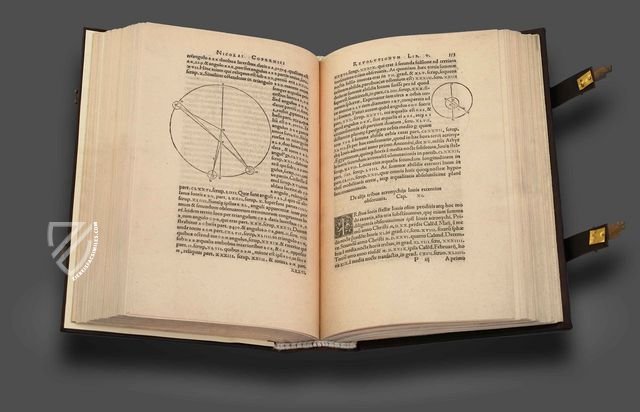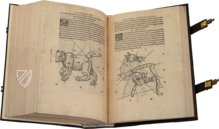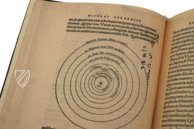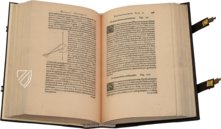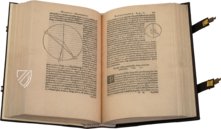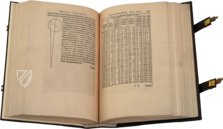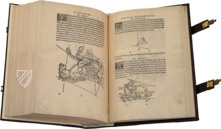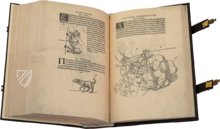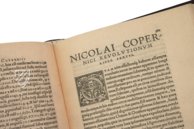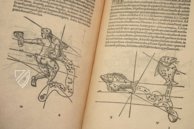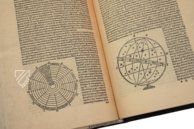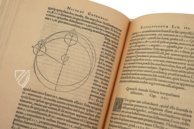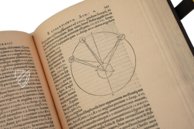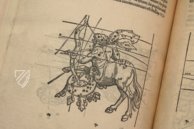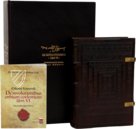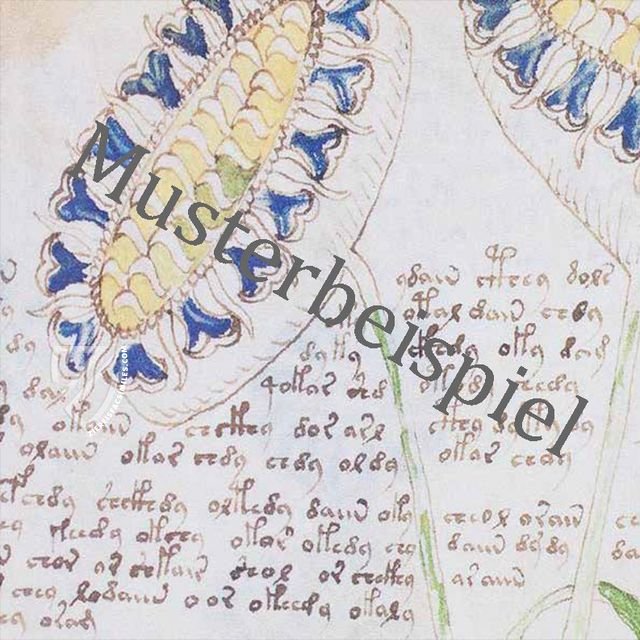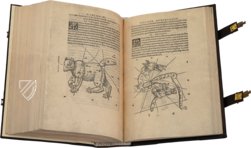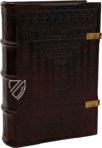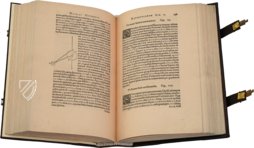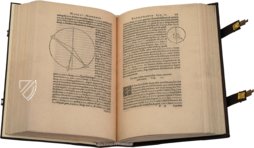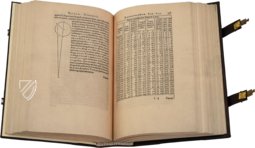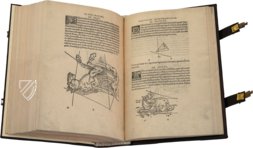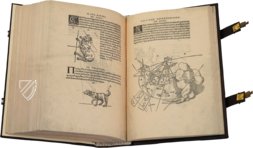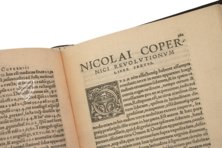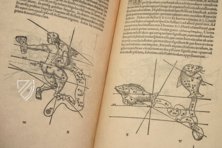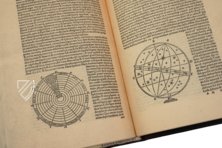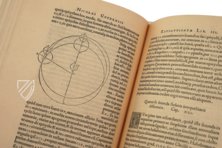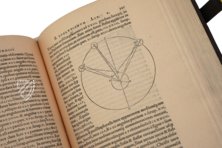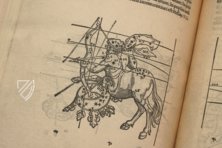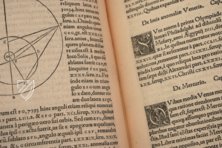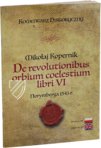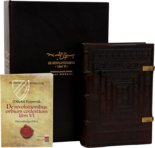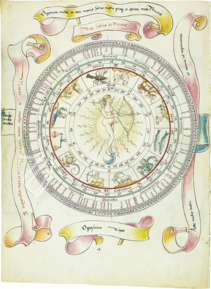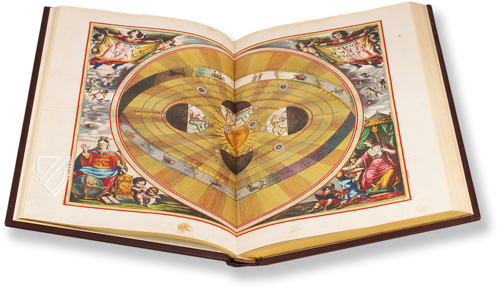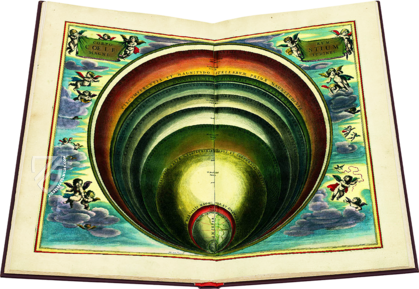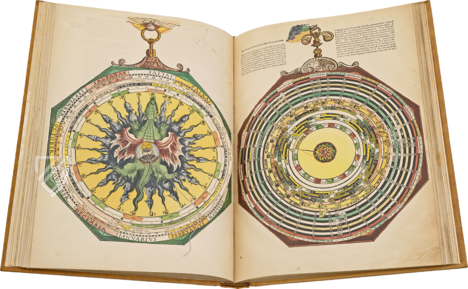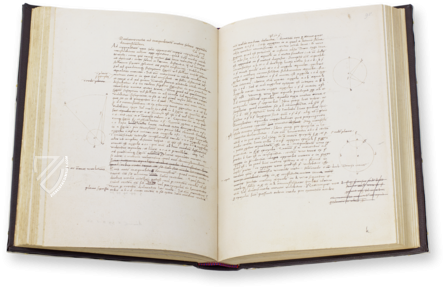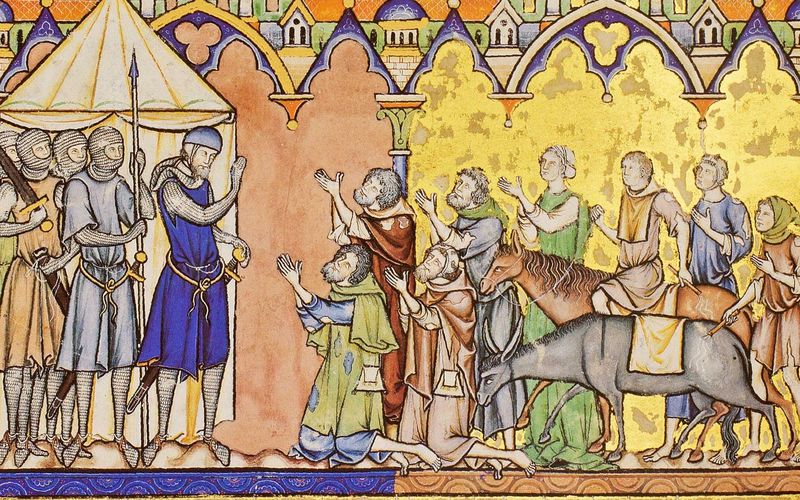Nicolaus Copernicus - De revolutionibus orbium coelestium libri VI
(1,000€ - 3,000€)
Nicolaus Copernicus (1473-1543) worked for over 15 years on his magnum opus entitled De revolutionibus orbium coelestium libri VI, which can be translated as On the Revolutions of the Heavenly Spheres in Six Books and was first printed and published in Nuremberg in 1543. Hardly any other early modern treatise has been of such great significance for the science, philosophy, mathematics and natural history of the universe. The unbelievably influential text is a milestone in Renaissance astronomy and provoked a shift in the thinking of a population still influenced by the world view of the Middle Ages: the geocentrism that had been unchallenged for centuries was thus replaced by a heliocentric conception of the universe. Until well into the 18th century, De revolutionibus orbium coelestium was an absolute standard work of science. In the wonderful first edition, which is kept in the Torún University Library, Copernicus' revolutionary findings are also accompanied by 148 precise woodcuts of astronomical figures.
Nicolaus Copernicus - De revolutionibus orbium coelestium libri VI
In the year 1543, the first edition of the primary work by Nicolaus Copernicus De revolutionibus orbium coelestium libri VI was published in Nuremberg. The translated title of the work is On the Revolutions of the Heavenly Spheres in Six Books. The work belongs among the milestones of astronomy during the modern era. It is a key work of the so-called Copernican Revolution and is considered to be a paradigm for a scientific revolution, in which the reigning medieval geocentric worldview was replaced by a heliocentric one. The findings of Copernicus regarding the Earth and the Universe were groundbreaking in every regard. His theories were based in mathematics and science and did away with religious superstition. The masterful treatise comprises six large parts, called books, which are illustrated with a total of 148 woodcut diagrams.
A Milestone of Astronomy
The work by Copernicus is a milestone of astronomy and its significance for the scientific and cultural history of the modern era can hardly be overestimated. Here, scientific research is very closely linked with philosophical questions. Inspired by the sources of Greek antiquity, above all Aristarchus of Samos, Heraclides Ponticus, and Philolaus, Copernicus developed a new worldview. Accordingly, the Earth moves along its own access and orbits the sun as the central star, like the other known planets. The Earth was seen as the stationary center of the universe for more than two thousand years. The undertaking by Copernicus was tremendous. He debunked millennia-old, unchallenged arguments against a mobile Earth. He discerned the heliocentric theory from decades of astronomical observations as well as mathematic calculations. Thus, he was able to soundly substantiate his groundbreaking theories. His work possesses such charisma that other scientists, especially Johannes Kepler and Galileo Galilei, built upon it and the great change of perspective was universally accepted only two hundred years later.
From Theory to Publication
Copernicus had already begun recording his theory in a short treatise ca. 1509, the so-called Commentariolus, a few excerpts of which were publically disclosed. After that, he was occupied with its scientific elaboration for some 30 years and began to transcribe his work ca. 1530. Numerous sources from this time exist in which the new theory was disseminated and discussed in the learned circles of Europe. In 1533, Pope Clement VII had his secretary explain it in a lecture. In September 1541, the Nuremberg publisher Johannes Petreius was granted the right to print the groundbreaking work, it was completed in early 1543. The first edition of around 400 printed pages organized the work of Copernicus into six books. The first book dealt with the foundations of the heliocentric worldview, the second the theory of heavenly phenomena, the third the apparent movements of the Sun, the fourth the movement of the Moon, the fifth and sixth with the length and breadth of the movements of the planets Saturn, Jupiter, Mars, Venus, and Mercury.
The Precious Edition of the Masterpiece
The historically interesting first edition of the Copernican work is stored today in the university library in the Polish city of Torun. There are various theories about the provenance of the edition. One theory says that it was purchased by the secretary of Duke Albert of Prussia, together with other high-quality masterpieces of literature. It was one of the first scientific treatises for the library of the University of Konigsberg, founded in 1544. One other theory claims that the work was a gift of the canon and close confidant of Albert’s, Georg Donner, to the Prussian Duke. In any case, a comprehensive primary work by Copernicus was united in 1543 into a unique codex and was furnished with a finely made leather binding by the bookbinder Caspar Angler. It remained in the collection of the library of the University of Konigsberg until 1944. It was brought to Torun during the turmoil of the Second World War, where it has been in the collection of the university library since ca. 1949.
Codicology
- Alternative Titles
- Mikołaj Kopernik - De revolutionibus orbium coelestium libri VI
- Size / Format
- 564 pages / 29.0 × 20.5 cm
- Origin
- Germany
- Date
- 1543
- Epochs
- Style
- Language
- Script
- Humanistic
- Illustrations
- 148 woodcuts of constellations and diagrams as well as numerous decorated initials
- Patron
- Georg Donner
- Artist / School
- Nicolaus Copernicus (1473–1543) (author)
Caspar Angler (d. 1565) (bookbinder) - Previous Owners
- Duke Albert of Prussia (1490–1568)
Castle Library (State and University Library) in Königsberg
Nicolaus Copernicus - De revolutionibus orbium coelestium libri VI
DE ARIETE
Not only is Aries one of the original 48 Ptolemaic constellations, it is associated with the ancient Greek myth of the Golden Fleece and has been recognized as a ram since the Babylonians. The woodcut shows a ram resting and graph lines represent the relative positions of the stars to one another in the constellation. Aries’ four bright stars align with its horns and the Bedouin, who navigated by the stars, literally called the two brightest the “horns of the ram” (qarna al-hamal).
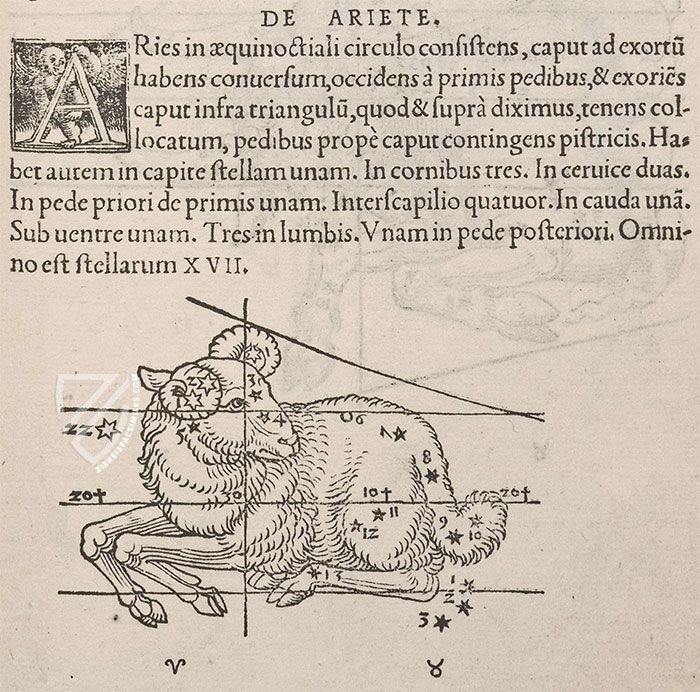
Nicolaus Copernicus - De revolutionibus orbium coelestium libri VI
DE DRACONE
This page is dedicated to the constellation Draco, one of the original 48 constellations listed by the ancient astronomer Ptolemy in the 2nd century BC, which is shown with a neighboring constellation, Ursa Minor (also known as the Little Dipper in North America). It is a circumpolar constellation, meaning that is never sets and can be seen all year from northern latitudes.
Oriented along the stars of the constellation, the mythological figure Draco is shown, which was one of the Gigantes that made war on the Olympic gods for ten years. It is a dragon that was killed by the goddess Mineva, becoming twisted up in the process and then frozen in this position after Minerva threw Draco across the sky and it passed by the North Pole.
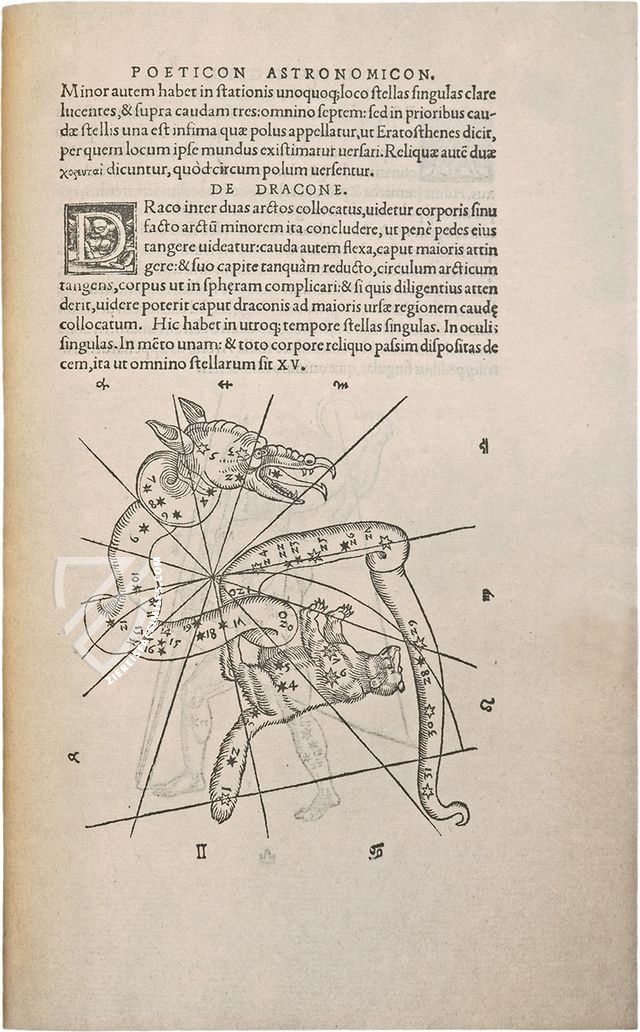
#1 Mikołaj Kopernik - De revolutionibus orbium coelestium libri VI
(1,000€ - 3,000€)
#2 Mikołaj Kopernik - De revolutionibus orbium coelestium libri VI
(1,000€ - 3,000€)
- Treatises / Secular Books
- Apocalypses / Beatus
- Astronomy / Astrology
- Bestiaries
- Bibles / Gospels
- Chronicles / History / Law
- Geography / Maps
- Saints' Lives
- Islam / Oriental
- Judaism / Hebrew
- Single Leaf Collections
- Leonardo da Vinci
- Literature / Poetry
- Liturgical Manuscripts
- Medicine / Botany / Alchemy
- Music
- Mythology / Prophecies
- Psalters
- Other Religious Books
- Games / Hunting
- Private Devotion Books
- Other Genres
- Afghanistan
- Armenia
- Austria
- Belgium
- Belize
- Bosnia and Herzegovina
- China
- Colombia
- Costa Rica
- Croatia
- Cyprus
- Czech Republic
- Denmark
- Egypt
- El Salvador
- Ethiopia
- France
- Germany
- Greece
- Guatemala
- Honduras
- Hungary
- India
- Iran
- Iraq
- Israel
- Italy
- Japan
- Jordan
- Kazakhstan
- Kyrgyzstan
- Lebanon
- Liechtenstein
- Luxembourg
- Mexico
- Morocco
- Netherlands
- Palestine
- Panama
- Peru
- Poland
- Portugal
- Romania
- Russia
- Serbia
- Spain
- Sri Lanka
- Sweden
- Switzerland
- Syria
- Tajikistan
- Turkey
- Turkmenistan
- Ukraine
- United Kingdom
- United States
- Uzbekistan
- Vatican City
- A. Oosthoek, van Holkema & Warendorf
- Aboca Museum
- Ajuntament de Valencia
- Akademie Verlag
- Akademische Druck- u. Verlagsanstalt (ADEVA)
- Aldo Ausilio Editore - Bottega d’Erasmo
- Alecto Historical Editions
- Alkuin Verlag
- Almqvist & Wiksell
- Amilcare Pizzi
- Andreas & Andreas Verlagsbuchhandlung
- Archa 90
- Archiv Verlag
- Archivi Edizioni
- Arnold Verlag
- ARS
- Ars Magna
- ArtCodex
- AyN Ediciones
- Azimuth Editions
- Badenia Verlag
- Bärenreiter-Verlag
- Belser Verlag
- Belser Verlag / WK Wertkontor
- Benziger Verlag
- Bernardinum Wydawnictwo
- BiblioGemma
- Biblioteca Apostolica Vaticana (Vaticanstadt, Vaticanstadt)
- Bibliotheca Palatina Faksimile Verlag
- Bibliotheca Rara
- Boydell & Brewer
- Bramante Edizioni
- Bredius Genootschap
- Brepols Publishers
- British Library
- C. Weckesser
- Caixa Catalunya
- Canesi
- CAPSA, Ars Scriptoria
- Caratzas Brothers, Publishers
- Carus Verlag
- Casamassima Libri
- Centrum Cartographie Verlag GmbH
- Chavane Verlag
- Christian Brandstätter Verlag
- Circulo Cientifico
- Club Bibliófilo Versol
- Club du Livre
- CM Editores
- Collegium Graphicum
- Collezione Apocrifa Da Vinci
- Comissão Nacional para as Comemorações dos Descobrimentos Portugueses
- Coron Verlag
- Corvina
- CTHS
- D. S. Brewer
- Damon
- De Agostini/UTET
- De Nederlandsche Boekhandel
- De Schutter
- Deuschle & Stemmle
- Deutscher Verlag für Kunstwissenschaft
- DIAMM
- Droz
- E. Schreiber Graphische Kunstanstalten
- Ediciones Boreal
- Ediciones Grial
- Ediclube
- Edições Inapa
- Edilan
- Editalia
- Edition Deuschle
- Edition Georg Popp
- Edition Leipzig
- Edition Libri Illustri
- Editiones Reales Sitios S. L.
- Éditions de l'Oiseau Lyre
- Editions Medicina Rara
- Editorial Casariego
- Editorial Mintzoa
- Editrice Antenore
- Editrice Velar
- Edizioni Edison
- Egeria, S.L.
- Eikon Editores
- Electa
- Emery Walker Limited
- Enciclopèdia Catalana
- Eos-Verlag
- Ephesus Publishing
- Ernst Battenberg
- Eugrammia Press
- Extraordinary Editions
- Fackelverlag
- Facsimila Art & Edition
- Facsimile Editions Ltd.
- Facsimilia Art & Edition Ebert KG
- Faksimile Verlag
- Feuermann Verlag
- Folger Shakespeare Library
- Franco Cosimo Panini Editore
- Friedrich Wittig Verlag
- Fundación Hullera Vasco-Leonesa
- G. Braziller
- Gabriele Mazzotta Editore
- Gebr. Mann Verlag
- Gesellschaft für graphische Industrie
- Getty Research Institute
- Giovanni Domenico de Rossi
- Giunti Editore
- Graffiti
- Grafica European Center of Fine Arts
- Guido Pressler
- Guillermo Blazquez
- Gustav Kiepenheuer
- H. N. Abrams
- Harrassowitz
- Harvard University Press
- Helikon
- Hendrickson Publishers
- Henning Oppermann
- Herder Verlag
- Hes & De Graaf Publishers
- Hoepli
- Holbein-Verlag
- Houghton Library
- Hugo Schmidt Verlag
- Idion Verlag
- Il Bulino, edizioni d'arte
- ILte
- Imago
- Insel Verlag
- Insel-Verlag Anton Kippenberger
- Instituto de Estudios Altoaragoneses
- Instituto Nacional de Antropología e Historia
- Introligatornia Budnik Jerzy
- Istituto dell'Enciclopedia Italiana - Treccani
- Istituto Ellenico di Studi Bizantini e Postbizantini
- Istituto Geografico De Agostini
- Istituto Poligrafico e Zecca dello Stato
- Italarte Art Establishments
- Jan Thorbecke Verlag
- Johnson Reprint Corporation
- Josef Stocker
- Josef Stocker-Schmid
- Jugoslavija
- Karl W. Hiersemann
- Kasper Straube
- Kaydeda Ediciones
- Kindler Verlag / Coron Verlag
- Kodansha International Ltd.
- Konrad Kölbl Verlag
- Kurt Wolff Verlag
- La Liberia dello Stato
- La Linea Editrice
- La Meta Editore
- Lambert Schneider
- Landeskreditbank Baden-Württemberg
- Leo S. Olschki
- Les Incunables
- Liber Artis
- Library of Congress
- Libreria Musicale Italiana
- Lichtdruck
- Lito Immagine Editore
- Lumen Artis
- Lund Humphries
- M. Moleiro Editor
- Maison des Sciences de l'homme et de la société de Poitiers
- Manuscriptum
- Martinus Nijhoff
- Maruzen-Yushodo Co. Ltd.
- MASA
- Massada Publishers
- McGraw-Hill
- Metropolitan Museum of Art
- Militos
- Millennium Liber
- Müller & Schindler
- Nahar - Stavit
- Nahar and Steimatzky
- National Library of Wales
- Neri Pozza
- Nova Charta
- Oceanum Verlag
- Odeon
- Orbis Mediaevalis
- Orbis Pictus
- Österreichische Staatsdruckerei
- Oxford University Press
- Pageant Books
- Parzellers Buchverlag
- Patrimonio Ediciones
- Pattloch Verlag
- PIAF
- Pieper Verlag
- Plon-Nourrit et cie
- Poligrafiche Bolis
- Presses Universitaires de Strasbourg
- Prestel Verlag
- Princeton University Press
- Prisma Verlag
- Priuli & Verlucca, editori
- Pro Sport Verlag
- Propyläen Verlag
- Pytheas Books
- Quaternio Verlag Luzern
- Reales Sitios
- Recht-Verlag
- Reichert Verlag
- Reichsdruckerei
- Reprint Verlag
- Riehn & Reusch
- Roberto Vattori Editore
- Rosenkilde and Bagger
- Roxburghe Club
- Salerno Editrice
- Saltellus Press
- Sandoz
- Sarajevo Svjetlost
- Schöck ArtPrint Kft.
- Schulsinger Brothers
- Scolar Press
- Scrinium
- Scripta Maneant
- Scriptorium
- Shazar
- Siloé, arte y bibliofilia
- SISMEL - Edizioni del Galluzzo
- Sociedad Mexicana de Antropología
- Société des Bibliophiles & Iconophiles de Belgique
- Soncin Publishing
- Sorli Ediciones
- Stainer and Bell
- Studer
- Styria Verlag
- Sumptibus Pragopress
- Szegedi Tudomànyegyetem
- Taberna Libraria
- Tarshish Books
- Taschen
- Tempus Libri
- Testimonio Compañía Editorial
- Thames and Hudson
- The Clear Vue Publishing Partnership Limited
- The Facsimile Codex
- The Folio Society
- The Marquess of Normanby
- The Richard III and Yorkist History Trust
- Tip.Le.Co
- TouchArt
- TREC Publishing House
- TRI Publishing Co.
- Trident Editore
- Tuliba Collection
- Typis Regiae Officinae Polygraphicae
- Union Verlag Berlin
- Universidad de Granada
- University of California Press
- University of Chicago Press
- Urs Graf
- Vallecchi
- Van Wijnen
- VCH, Acta Humaniora
- VDI Verlag
- VEB Deutscher Verlag für Musik
- Verlag Anton Pustet / Andreas Verlag
- Verlag Bibliophile Drucke Josef Stocker
- Verlag der Münchner Drucke
- Verlag für Regionalgeschichte
- Verlag Styria
- Vicent Garcia Editores
- W. Turnowski Ltd.
- W. Turnowsky
- Waanders Printers
- Wiener Mechitharisten-Congregation (Wien, Österreich)
- Wissenschaftliche Buchgesellschaft
- Wissenschaftliche Verlagsgesellschaft
- Wydawnictwo Dolnoslaskie
- Xuntanza Editorial
- Zakład Narodowy
- Zollikofer AG

